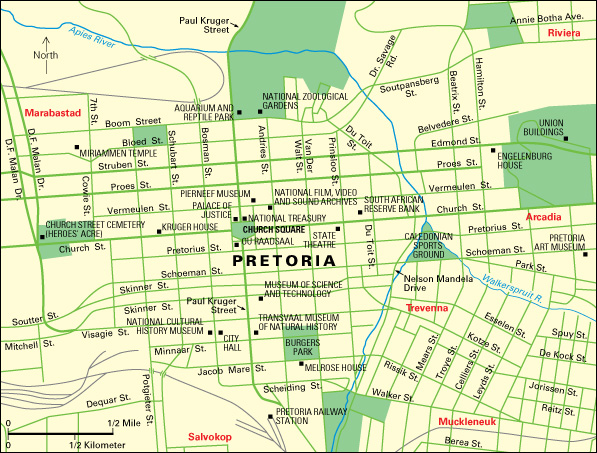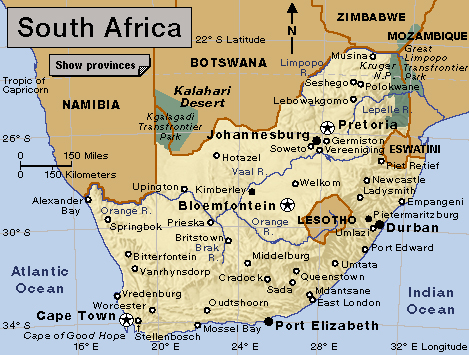Pretoria << prih TOHR ee uh >> is the administrative capital of South Africa and one of the country’s largest cities. It lies in northeastern South Africa, in the northern part of the province of Gauteng. The executive branch of the South African government directs the country’s administrative affairs from Pretoria. Cape Town is South Africa’s legislative capital, and Bloemfontein is the judicial capital.

Pretoria lies in the foothills of the Magaliesberg mountains. Because of its lower altitude, it is warmer than the nearby city of Johannesburg. Pretoria is known as the Jacaranda City, because of the jacaranda trees that bloom there. Pretoria is part of the Tshwane metropolitan municipality, which was established in 2000. Tshwane has a population of 4,040,315.
The city.
Pretoria lies in two sheltered and fertile valleys. Several ridges run through the city from east to west. The main river is the Apies.
Church Square serves as the center of Pretoria. Church Street is the main street running east to west through the square. It is more than 15 miles (24 kilometers) long. Paul Kruger Street is the main street running north to south through Church Square. The central business district is located around the square. The region’s main industrial areas are Waltloo and Rosslyn.
There are many parks and gardens in the city. They include Burgers Park, Fountains Valley, the Austin Roberts Bird Sanctuary, the National Botanical Garden, the National Zoological Gardens, and the Aquarium and Reptile Park. Pretoria’s landmarks include the Union Buildings, which are the administrative headquarters of the South African government, and the Voortrekker Monument, on a hill outside the city.
Heroes’ Acre is a cemetery where many of Pretoria’s famous people are buried, including the pioneer Andries Pretorius, Prime Minister Hendrik Verwoerd, and President Paul Kruger. The Miriammen Temple, the oldest Hindu temple in Pretoria, was built in 1905. There are numerous churches, cathedrals, and mosques (Muslim houses of worship).
In 1995, a few years after the end of South Africa’s system of apartheid (racial segregation), Pretoria was merged with the Black African townships of Mamelodi and Atteridgeville, the Coloured (mixed-race) township of Eersterus, and the Indian township of Laudium. At the same time, the nearby white community of Akasia was merged with the Black African township of Soshanguve and other Black townships. Pretoria and Akasia, together with their former township areas, were merged with the white community of Centurion to form the Greater Pretoria Metropolitan Area.
In 2000, the Greater Pretoria Metropolitan Area was merged with the Black African communities of Ga-Rankuwa, Hammanskraal, Mabopane, Temba, and Winterveld, along with other nearby communities and rural areas. This merger formed the Tshwane metropolitan municipality. Tshwane lies mostly in Gauteng province. A portion of Tshwane lies in North West province. The municipality has a total area of 849 square miles (2,199 square kilometers) and a population of about 2 million.
People.
A large majority of Pretoria’s people are of African descent. People of European descent make up the second largest group. People of Asian descent and Coloured people account for a small percentage of the population.
Education and cultural life.
The University of South Africa (UNISA), a large correspondence university, has its headquarters in Pretoria. The Tshwane University of Technology, also headquartered in Pretoria, was formed in 2004 with the merger of three technikons (vocational schools). The University of Pretoria, chartered in 1930, is the largest residential university in South Africa. The university’s faculty of veterinary sciences is at Onderstepoort, north of Pretoria. Onderstepoort is South Africa’s leading school for veterinary surgeons.
The State Theatre is the base of the performing arts in Pretoria. Operas, ballets, drama, dance, and music are staged at the Stage Theatre, as well as in the City Hall.
Pretoria’s main sports stadium is the Loftus Versfeld Stadium. The city’s numerous museums and galleries include the Pretoria Art Museum, Pierneef Museum, and the National Cultural History Museum.
Economy.
Pretoria is a business, government, and service center. The major industrial products are cement, chemicals, electronic equipment, furniture, glass, machinery, motor vehicles, paper, plastics, and tobacco. Steel works in the city were set up in 1928. Wonderboom is the local airport, and Johannesburg’s OR Tambo International Airport is about 30 miles (48 kilometers) from Pretoria. A high-speed rail network connects Pretoria with Johannesburg.
The majority of Pretoria’s workers are employed in the service sector. This sector includes government, administration, and social services. The city has a large number of government departments, which employ thousands of civil servants. Other workers are employed in transportation, tourism, education, or trade.
Government.
The Tshwane municipality, which includes the city of Pretoria, is one of South Africa’s six metropolitan municipalities. The others are Cape Town; Johannesburg; eThekwini, which includes the city of Durban; Ekurhuleni, also known as the East Rand; and Nelson Mandela Bay, which includes the city of Port Elizabeth. An executive mayor and a municipal council oversee the Tshwane municipality. Tshwane houses the South African Mint, the Government Printing Works, and the military headquarters of the South African Defence Force.

History.
In the 1400’s, Sotho-speaking people settled in the Pretoria area. Nguni-speaking people of the Ndebele group joined them in the early 1600’s. In the mid-1800’s, groups of voortrekker families settled in the Transvaal region, in what is now northern South Africa. Voortrekkers were Afrikaners—people of Dutch and other European descent—who migrated from the nearby Cape Colony. They were seeking independence from British colonial rule. The main voortrekker settlements were at Potchefstroom and Lydenburg. In 1855, Marthinus Pretorius established a permanent settlement. Pretoria was named after Andries Pretorius, the father of Marthinus.
The Transvaal was renamed the Zuid-Afrikaansche Republiek (South African Republic), and Marthinus Pretorius became its first president. In 1860, Pretoria became its headquarters. In 1895, the railroad from Delagoa Bay on the Indian Ocean reached Pretoria. The Treaty of Vereeniging ending the Anglo-Boer War of 1899-1902 was signed by representatives of the United Kingdom and the Boers (Afrikaners) in Pretoria. In 1910, Pretoria was named as administrative capital of the Union of South Africa and administrative capital of the Transvaal province. Pretoria became the administrative capital of the Republic of South Africa in 1961.
When the Pretoria-Witwatersrand–Vereeniging province (now Gauteng) came into being in 1994, the administration of the new province passed to Johannesburg, and Pretoria ceased to be a provincial capital. Later in the 1990’s, Pretoria was merged with a number of townships that had been separate communities under apartheid. In 2000, the Tshwane metropolitan municipality was created, with Pretoria as its central city. Since then, members of the Tshwane municipal council have made some efforts to also change Pretoria’s name to Tshwane. These efforts have been strongly opposed by many Afrikaners.
